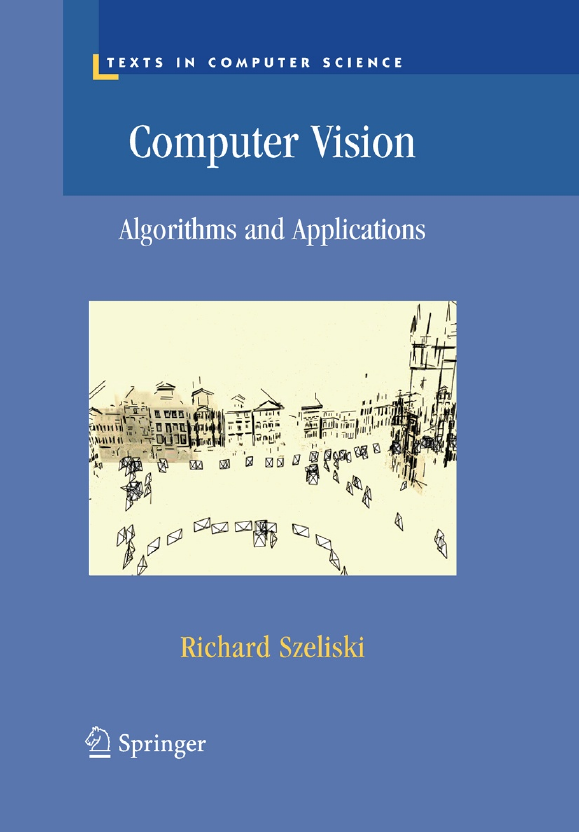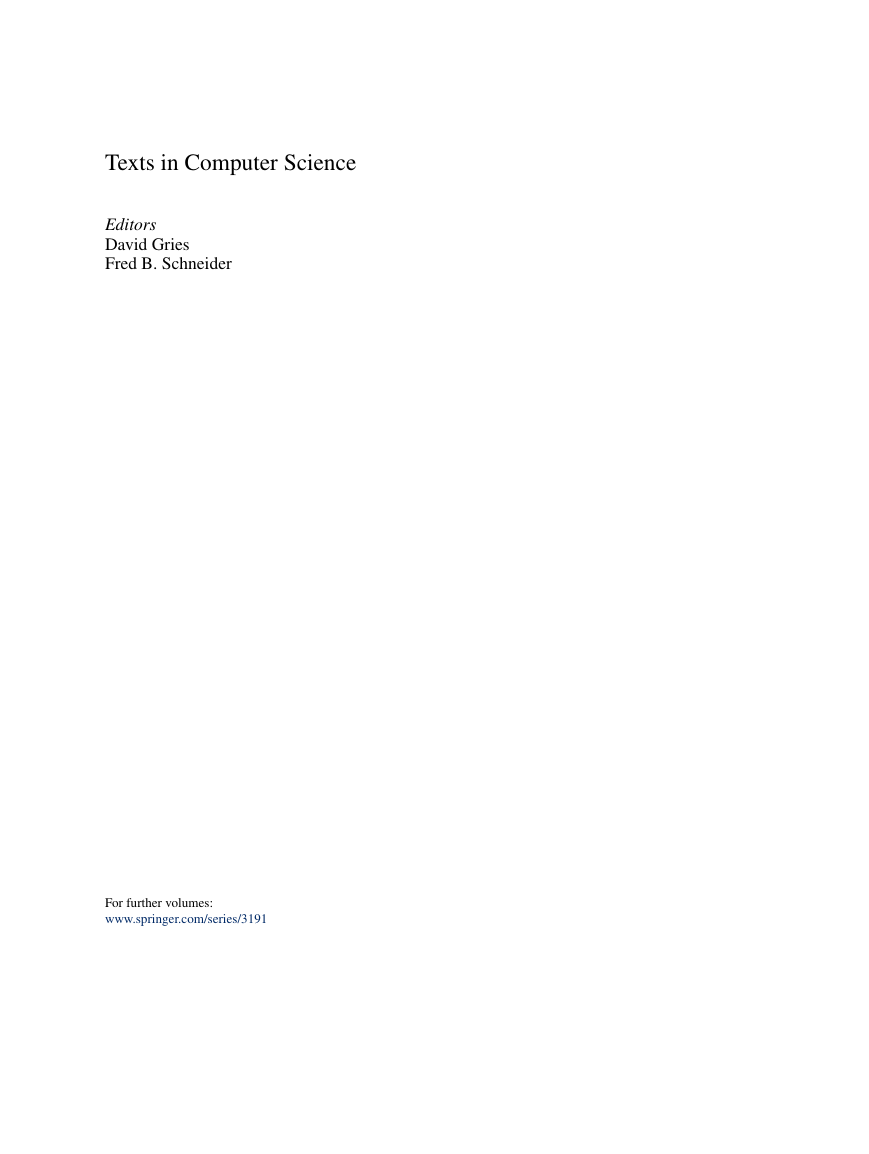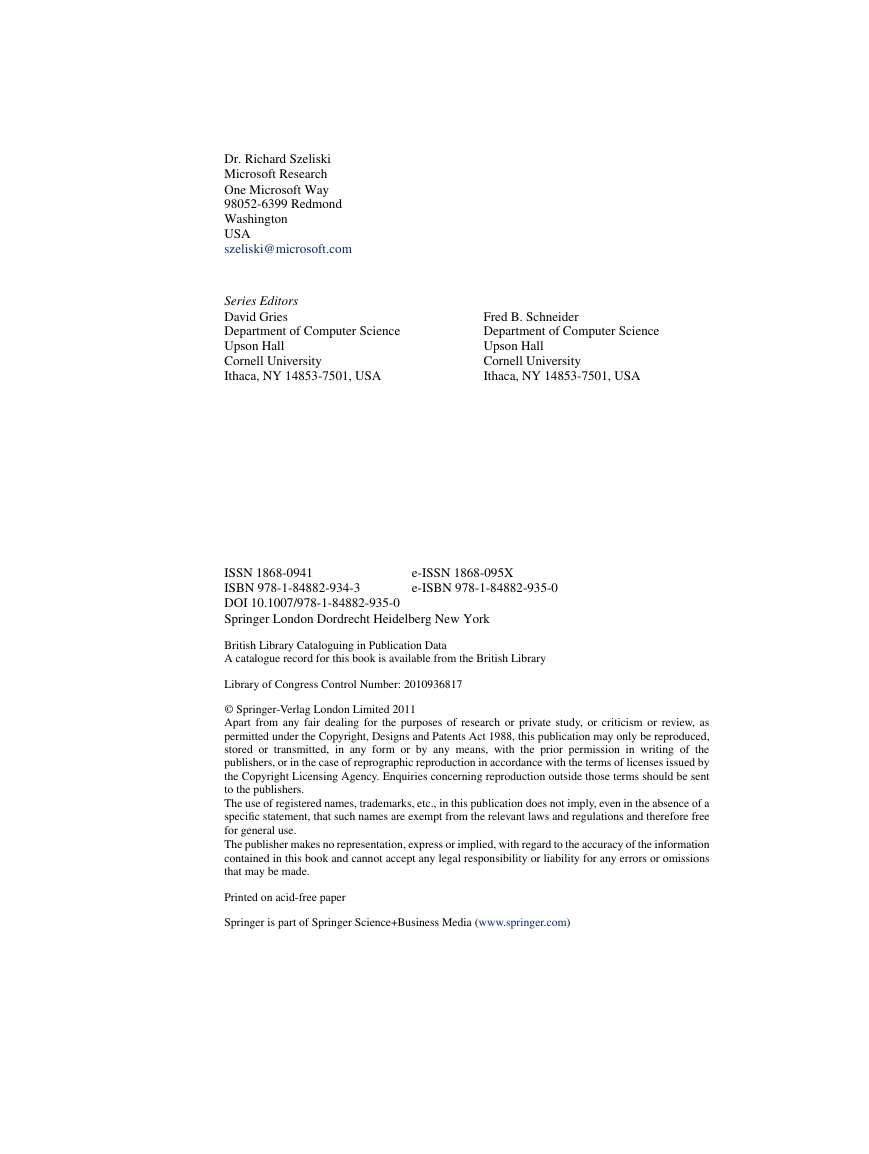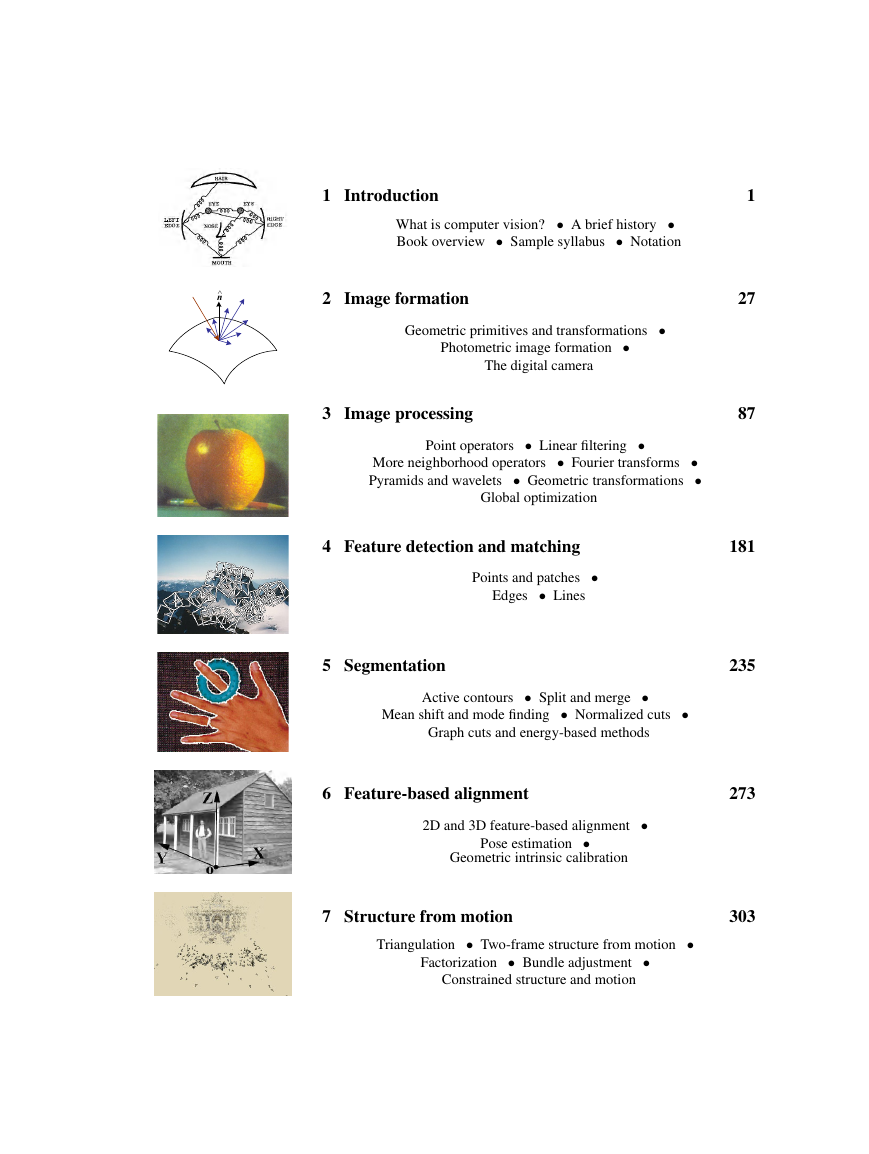Cover
Computer Vision: Algorithms and Applications
Copyright
9781848829343
Preface
Acknowledgements
Contents
Chapter 1 Introduction
1.1 What is computer vision?
1.2 A brief history
1.3 Book overview
1.4 Sample syllabus
1.5 A note on notation
1.6 Additional reading
Chapter 2 Image formation
2.1 Geometric primitives and transformations
2.1.1 Geometric primitives
2.1.2 2D transformations
2.1.3 3D transformations
2.1.4 3D rotations
Euler angles
Axis/angle (exponential twist)
Unit quaternions
Which rotation representation is better?
2.1.5 3D to 2D projections
Orthography and para-perspective
Perspective
Camera intrinsics
A note on focal lengths
Camera matrix
Plane plus parallax (projective depth)
Mapping from one camera to another
Object-centered projection
2.1.6 Lens distortions
2.2 Photometric image formation
2.2.1 Lighting
2.2.2 Reflectance and shading
The Bidirectional Reflectance Distribution Function (BRDF)
Diffuse reflection
Specular reflection
Phong shading
Di-chromatic reflection model
Global illumination (ray tracing and radiosity)
2.2.3 Optics
Chromatic aberration
Vignetting
2.3 The digital camera
2.3.1 Sampling and aliasing
2.3.2 Color
CIE RGB and XYZ
L*a*b* color space
Color cameras
Color filter arrays
Color balance
Gamma
Other color spaces
2.3.3 Compression
2.4 Additional reading
2.5 Exercises
Chapter 3 Image processing
3.1 Point operators
3.1.1 Pixel transforms
3.1.2 Color transforms
3.1.3 Compositing and matting
3.1.4 Histogram equalization
Locally adaptive histogram equalization
3.1.5 Application: Tonal adjustment
3.2 Linear filtering
Padding (border effects)
3.2.1 Separable filtering
3.2.2 Examples of linear filtering
3.2.3 Band-pass and steerable filters
Summed area table (integral image)
Recursive filtering
3.3 More neighborhood operators
3.3.1 Non-linear filtering
Median filtering
Bilateral filtering
Iterated adaptive smoothing and anisotropic diffusion
3.3.2 Morphology
3.3.3 Distance transforms
3.3.4 Connected components
3.4 Fourier transforms
3.4.1 Fourier transform pairs
3.4.2 Two-dimensional Fourier transforms
3.4.3 Wiener filtering
Discrete cosine transform
3.4.4 Application: Sharpening, blur, and noise removal
3.5 Pyramids and wavelets
3.5.1 Interpolation
3.5.2 Decimation
3.5.3 Multi-resolution representations
3.5.4 Wavelets
3.5.5 Application: Image blending
3.6 Geometric transformations
3.6.1 Parametric transformations
MIP-mapping
Elliptical Weighted Average
Anisotropic filtering
Multi-pass transforms
3.6.2 Mesh-based warping
3.6.3 Application: Feature-based morphing
3.7 Global optimization
3.7.1 Regularization
3.7.2 Markov random fields
3.7.3 Application: Image restoration
3.8 Additional reading
3.9 Exercises
Chapter 4 Feature detection and matching
4.1 Points and patches
4.1.1 Feature detectors
Scale invariance
Rotational invariance and orientation estimation
Affine invariance
4.1.2 Feature descriptors
4.1.3 Feature matching
Matching strategy and error rates
Efficient matching
Feature match verification and densification
4.1.4 Feature tracking
4.1.5 Application: Performance-driven animation
4.2 Edges
4.2.1 Edge detection
Scale selection and blur estimation
Color edge detection
Combining edge feature cues
4.2.2 Edge linking
4.2.3 Application: Edge editing and enhancement
4.3 Lines
4.3.1 Successive approximation
4.3.2 Hough transforms
4.3.3 Vanishing points
4.3.4 Application: Rectangle detection
4.4 Additional reading
4.5 Exercises
Chapter 5 Segmentation
5.1 Active contours
5.1.1 Snakes
Elastic nets and slippery springs
Splines and shape priors
5.1.2 Dynamic snakes and CONDENSATION
5.1.3 Scissors
5.1.4 Level Sets
5.1.5 Application: Contour tracking and rotoscoping
5.2 Split and merge
5.2.1 Watershed
5.2.2 Region splitting (divisive clustering)
5.2.3 Region merging (agglomerative clustering)
5.2.4 Graph-based segmentation
5.2.5 Probabilistic aggregation
5.3 Mean shift and mode finding
5.3.1 K-means and mixtures of Gaussians
5.3.2 Mean shift
5.4 Normalized cuts
5.5 Graph cuts and energy-based methods
5.5.1 Application: Medical image segmentation
5.6 Additional reading
5.7 Exercises
Chapter 6 Feature-based alignment
6.1 2D and 3D feature-based alignment
6.1.1 2D alignment using least squares
6.1.2 Application: Panography
6.1.3 Iterative algorithms
6.1.4 Robust least squares and RANSAC
Uncertainty modeling
6.1.5 3D alignment
6.2 Pose estimation
6.2.1 Linear algorithms
6.2.2 Iterative algorithms
6.2.3 Application: Augmented reality
6.3 Geometric intrinsic calibration
6.3.1 Calibration patterns
Planar calibration patterns
6.3.2 Vanishing points
6.3.3 Application: Single view metrology
6.3.4 Rotational motion
6.3.5 Radial distortion
6.4 Additional reading
6.5 Exercises
Chapter 7 Structure from motion
7.1 Triangulation
7.2 Two-frame structure from motion
Pure translation (known rotation)
Pure rotation
7.2.1 Projective (uncalibrated) reconstruction
7.2.2 Self-calibration
7.2.3 Application: View morphing
7.3 Factorization
7.3.1 Perspective and projective factorization
7.3.2 Application: Sparse 3D model extraction
7.4 Bundle adjustment
7.4.1 Exploiting sparsity
7.4.2 Application: Match move and augmented reality
7.4.3 Uncertainty and ambiguities
7.4.4 Application: Reconstruction from Internet photos
7.5 Constrained structure and motion
7.5.1 Line-based techniques
7.5.2 Plane-based techniques
7.6 Additional reading
7.7 Exercises
Chapter 8 Dense motion estimation
8.1 Translational alignment
8.1.1 Hierarchical motion estimation
8.1.2 Fourier-based alignment
8.1.3 Incremental refinement
8.2 Parametric motion
8.2.1 Application: Video stabilization
8.2.2 Learned motion models
8.3 Spline-based motion
8.3.1 Application: Medical image registration
8.4 Optical flow
8.4.1 Multi-frame motion estimation
8.4.2 Application: Video denoising
8.4.3 Application: De-interlacing
8.5 Layered motion
8.5.1 Application: Frame interpolation
8.5.2 Transparent layers and reflections
8.6 Additional reading
8.7 Exercises
Chapter 9 Image stitching
9.1 Motion models
9.1.1 Planar perspective motion
9.1.2 Application: Whiteboard and document scanning
9.1.3 Rotational panoramas
9.1.4 Gap closing
9.1.5 Application: Video summarization and compression
9.1.6 Cylindrical and spherical coordinates
9.2 Global alignment
9.2.1 Bundle adjustment
9.2.2 Parallax removal
9.2.3 Recognizing panoramas
9.2.4 Direct vs. feature-based alignment
9.3 Compositing
9.3.1 Choosing a compositing surface
9.3.2 Pixel selection and weighting (de-ghosting)
9.3.3 Application: Photomontage
9.3.4 Blending
9.4 Additional reading
9.5 Exercises
Chapter 10 Computational photography
10.1 Photometric calibration
10.1.1 Radiometric response function
10.1.2 Noise level estimation
10.1.3 Vignetting
10.1.4 Optical blur (spatial response) estimation
10.2 High dynamic range imaging
10.2.1 Tone mapping
10.2.2 Application: Flash photography
10.3 Super-resolution and blur removal
10.3.1 Color image demosaicing
10.3.2 Application: Colorization
10.4 Image matting and compositing
10.4.1 Blue screen matting
10.4.2 Natural image matting
10.4.3 Optimization-based matting
10.4.4 Smoke, shadow, and flash matting
10.4.5 Video matting
10.5 Texture analysis and synthesis
10.5.1 Application: Hole filling and inpainting
10.5.2 Application: Non-photorealistic rendering
10.6 Additional reading
10.7 Exercises
Chapter 11 Stereo correspondence
11.1 Epipolar geometry
11.1.1 Rectification
11.1.2 Plane sweep
11.2 Sparse correspondence
11.2.1 3D curves and profiles
11.3 Dense correspondence
11.3.1 Similarity measures
11.4 Local methods
11.4.1 Sub-pixel estimation and uncertainty
11.4.2 Application: Stereo-based head tracking
11.5 Global optimization
11.5.1 Dynamic programming
11.5.2 Segmentation-based techniques
11.5.3 Application: Z-keying and background replacement
11.6 Multi-view stereo
11.6.1 Volumetric and 3D surface reconstruction
11.6.2 Shape from silhouettes
11.7 Additional reading
11.8 Exercises
Chapter 12 3D reconstruction
12.1 Shape from X
12.1.1 Shape from shading and photometric stereo
12.1.2 Shape from texture
12.1.3 Shape from focus
12.2 Active rangefinding
12.2.1 Range data merging
12.2.2 Application: Digital heritage
12.3 Surface representations
12.3.1 Surface interpolation
12.3.2 Surface simplification
12.3.3 Geometry images
12.4 Point-based representations
12.5 Volumetric representations
12.5.1 Implicit surfaces and level sets
12.6 Model-based reconstruction
12.6.1 Architecture
12.6.2 Heads and faces
12.6.3 Application: Facial animation
12.6.4 Whole body modeling and tracking
12.7 Recovering texture maps and albedos
12.7.1 Estimating BRDFs
12.7.2 Application: 3D photography
12.8 Additional reading
12.9 Exercises
Chapter 13 Image-based rendering
13.1 View interpolation
13.1.1 View-dependent texture maps
13.1.2 Application: Photo Tourism
13.2 Layered depth images
13.2.1 Impostors, sprites, and layers
13.3 Light fields and Lumigraphs
13.3.1 Unstructured Lumigraph
13.3.2 Surface light fields
13.3.3 Application: Concentric mosaics
13.4 Environment mattes
13.4.1 Higher-dimensional light fields
13.4.2 The modeling to rendering continuum
13.5 Video-based rendering
13.5.1 Video-based animation
13.5.2 Video textures
13.5.3 Application: Animating pictures
13.5.4 3D Video
13.5.5 Application: Video-based walkthroughs
13.6 Additional reading
13.7 Exercises
Chapter 14 Recognition
14.1 Object detection
14.1.1 Face detection
14.1.2 Pedestrian detection
14.2 Face recognition
14.2.1 Eigenfaces
14.2.2 Active appearance and 3D shape models
14.2.3 Application: Personal photo collections
14.3 Instance recognition
14.3.1 Geometric alignment
14.3.2 Large databases
14.3.3 Application: Location recognition
14.4 Category recognition
14.4.1 Bag of words
14.4.2 Part-based models
14.4.3 Recognition with segmentation
14.4.4 Application: Intelligent photo editing
14.5 Context and scene understanding
14.5.1 Learning and large image collections
14.5.2 Application: Image search
14.6 Recognition databases and test sets
14.7 Additional reading
14.8 Exercises
Chapter 15 Conclusion
Appendix A Linear algebra and numerical techniques
A.1 Matrix decompositions
A.1.1 Singular value decomposition
A.1.2 Eigenvalue decomposition
A.1.3 QR factorization
A.1.4 Cholesky factorization
A.2 Linear least squares
A.2.1 Total least squares
A.3 Non-linear least squares
A.4 Direct sparse matrix techniques
A.4.1 Variable reordering
A.5 Iterative techniques
A.5.1 Conjugate gradient
A.5.2 Preconditioning
A.5.3 Multigrid
Appendix B Bayesian modeling and inference
B.1 Estimation theory
B.1.1 Likelihood for multivariate Gaussian noise
B.2 Maximum likelihood estimation and least squares
B.3 Robust statistics
B.4 Prior models and Bayesian inference
B.5 Markov random fields
B.5.1 Gradient descent and simulated annealing
B.5.2 Dynamic programming
B.5.3 Belief propagation
B.5.4 Graph cuts
B.5.5 Linear programming
B.6 Uncertainty estimation (error analysis)
Appendix C Supplementary material
C.1 Data sets
C.2 Software
C.3 Slides and lectures
C.4 Bibliography
References
Index
















 2023年江西萍乡中考道德与法治真题及答案.doc
2023年江西萍乡中考道德与法治真题及答案.doc 2012年重庆南川中考生物真题及答案.doc
2012年重庆南川中考生物真题及答案.doc 2013年江西师范大学地理学综合及文艺理论基础考研真题.doc
2013年江西师范大学地理学综合及文艺理论基础考研真题.doc 2020年四川甘孜小升初语文真题及答案I卷.doc
2020年四川甘孜小升初语文真题及答案I卷.doc 2020年注册岩土工程师专业基础考试真题及答案.doc
2020年注册岩土工程师专业基础考试真题及答案.doc 2023-2024学年福建省厦门市九年级上学期数学月考试题及答案.doc
2023-2024学年福建省厦门市九年级上学期数学月考试题及答案.doc 2021-2022学年辽宁省沈阳市大东区九年级上学期语文期末试题及答案.doc
2021-2022学年辽宁省沈阳市大东区九年级上学期语文期末试题及答案.doc 2022-2023学年北京东城区初三第一学期物理期末试卷及答案.doc
2022-2023学年北京东城区初三第一学期物理期末试卷及答案.doc 2018上半年江西教师资格初中地理学科知识与教学能力真题及答案.doc
2018上半年江西教师资格初中地理学科知识与教学能力真题及答案.doc 2012年河北国家公务员申论考试真题及答案-省级.doc
2012年河北国家公务员申论考试真题及答案-省级.doc 2020-2021学年江苏省扬州市江都区邵樊片九年级上学期数学第一次质量检测试题及答案.doc
2020-2021学年江苏省扬州市江都区邵樊片九年级上学期数学第一次质量检测试题及答案.doc 2022下半年黑龙江教师资格证中学综合素质真题及答案.doc
2022下半年黑龙江教师资格证中学综合素质真题及答案.doc